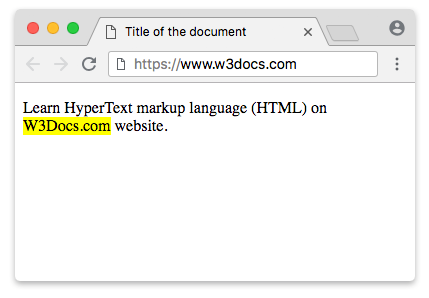The <mark> tag is one of the HTML5 elements. It marks a part of the text which has relevance. It can be used to highlight text for showing emphasis, highlight search terms in search results to provide context; or distinguish new content added by user showing it differently.
In the Chrome and Firefox the tag content is marked in yellow, but it can be changed with the CSS background-color property .
The <mark> tag can be used for indicating a particular part of the content relevant to the current activity of the user, like indicating the words matching a search operation.
Syntax
The <mark> tag comes in pairs. The content is written between the opening (<mark>) and closing (</mark>) tags.
Example of the HTML <mark> tag:
<!DOCTYPE html>
<html>
<head>
<title>Title of the document</title>
</head>
<body>
<p>Learn HyperText markup language (HTML) on <mark>W3Docs.com</mark> website.</p>
</body>
</html>Result

The <mark> and other HTML tags
A list of some HTML elements that have similarities with the <mark> element is presented below. Let’s go through each of them.
The HTML <strong> tag
You can use the <strong> tag for indicating text or part of the text that is very important. For example an error or a warning. It will appear as bold.
The HTML <b> tag
The <b> tag has some similarities with <strong>. It appears as bold too. The main difference is that the <b> element doesn’t indicate any importance. It is used for design purposes.
The HTML <em> tag
We use the <em> tag to stress emphasis on a specific word. It appears as italics.
Attributes
The <mark> tag supports the Global attributes and the Event Attributes.
How to style <mark> tag?
Common properties to alter the visual weight/emphasis/size of text in <mark> tag:
- CSS font-style property sets the style of the font. normal | italic | oblique | initial | inherit.
- CSS font-family property specifies a prioritized list of one or more font family names and/or generic family names for the selected element.
- CSS font-size property sets the size of the font.
- CSS font-weight property defines whether the font should be bold or thick.
- CSS text-transform property controls text case and capitalization.
- CSS text-decoration property specifies the decoration added to text, and is a shorthand property for text-decoration-line, text-decoration-color, text-decoration-style.
Coloring text in <mark> tag:
- CSS color property describes the color of the text content and text decorations.
- CSS background-color property sets the background color of an element.
Text layout styles for <mark> tag:
- CSS text-indent property specifies the indentation of the first line in a text block.
- CSS text-overflow property specifies how overflowed content that is not displayed should be signalled to the user.
- CSS white-space property specifies how white-space inside an element is handled.
- CSS word-break property specifies where the lines should be broken.
Other properties worth looking at for <mark> tag:
- CSS text-shadow property adds shadow to text.
- CSS text-align-last property sets the alignment of the last line of the text.
- CSS line-height property specifies the height of a line.
- CSS letter-spacing property defines the spaces between letters/characters in a text.
- CSS word-spacing property sets the spacing between words.
Browser support
|
|
|
|
|
|---|---|---|---|
| 6+ | 4+ | 5+ | 11.1+ |
Practice Your Knowledge
Quiz Time: Test Your Skills!
Ready to challenge what you've learned? Dive into our interactive quizzes for a deeper understanding and a fun way to reinforce your knowledge.